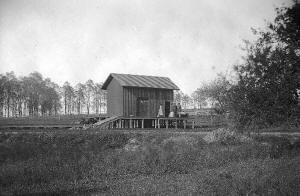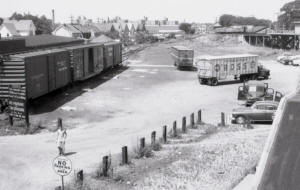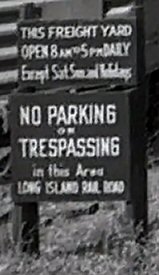The Freight
House
by Dave Keller
"...When the LIRR opened through to Greenport on July 27, 1844, once it left Jamaica, it passed through an uninhabited wilderness and served none of the old established and populous villages strung out along the south shore. Persons wishing to reach Brooklyn and Manhattan by rail had to make their way along the primitive roads inland to one of the lonely LIRR stations in the center of the island, and as this traffic grew, various stage coach routes sprang up to meet the increasing demand for public transportation. Several lines like the Deer Park-Babylon stage and the Hempstead-Freeport stage ran on regular schedules and carried many passengers..." Vincent F. Seyfried
By 1850, a railroad was completed along the shore
line of Connecticut, thus opening an all rail route to Boston and the Long
Island Railroad lost all its Boston business. This left the fledgling LIRR to
seek alternate revenue sources. I'll submit that at this point freight may
have become a reality as people hauling goods from the south shore to the
Main line in the Long Island middle pine barren to ship became a fiscal
reality. I would envision in the
very early days freight would just be added
to a passenger car as the earliest form of less than carload goods!
These earliest freight operations would comprise nothing
more than merchandise inclusion at the local station stop handled by the
station agent, later to be handled by a freight agent at a larger freight
station facility.
%20Agent%20M.%20E.%20Bloomer%20-%20View%20SE%20-c.%201880_small.jpg)
Waverly Station (Holtsville) Agent Mrs. M. E. Bloomer
View SE -c. 1880 - Archive: Wm. Biesecker

Setauket combination depot freight house.
View N/NE
The platform and freight ramp are on the west side. 10/1878 Photo: George
Brainerd Archive: John Lisi

Port Jefferson station and freight house (left)
View E 1878 Photo: George Brainerd
Archive: Dave Keller

Good Ground Station 1878 (Brainerd-Queensborough Library) 2nd depot opened: 1/10/1874, closed: 1913, used as express house for the 3rd depot.
%20(View%20NE)%20%20-%20c.%201878%20(Brainerd)_small.jpg)
Blue Point, South Side Rail Road view E - 1878
Photo: George Brainerd Archive: Art Huneke
Note: High level express loading platforms (2), but no express house.
Dave Keller

Westhampton Station and Freight House 1879
Photo: George Brainerd Archive: Dave
Keller
_small.jpg)
Bushwick Station and Freight House (left)
c. 1900 - Archive: Dave Keller

Freight/Express house - Valley Stream at
Rockaway Ave. - View NE c.1902+

Peconic Station rear 1905 Photo: Josiah C. Case Archive: Queens Public
Library
Note: An example of a small station that handled ticket sales, baggage AND
express services as the short,
high-level platform at the rear would be the express loading dock for The
Long Island Express. Dave Keller

LIRR valuation photo of the freight station at Broadway, Flushing 11/4/1918
Archive: Dave Keller

LIRR Freight Office Palmetto St., Ridgewood BUDD RDC railfan extra Evergreen Branch 9/09/1956
Photo: Rolf Schneider Archive: Dave Keller

Blissville freight house 12/1970
Photo/Archive: Dave Keller
FREIGHT & EXPRESS HOUSES: Larger depots had
both express houses and a freight depot, Patchogue for
example. These were long, rectangular buildings with hip roofs, and
high-level platforms on multiple sides with the back open to allow trucks a
loading
or unloading dock. These freight depots,
built of both wood or brick probably handled sufficient business to have
their own freight agent.
This style was
used at Patchogue, Babylon, Northport, Camp Upton, Huntington, Floral Park,
etc. to name but a few and virtually existed over the entire LIRR. A similar style
was used at Greenport, Oyster Bay, Oakdale, and
Amagansett,
but were of brick
construction.

Patchogue Freight House composite view SW 03/1946
Built c. <1900
Photo: Fred Weber Archive: Dave Keller Composite: Steven Lynch

Camp Upton Freight station – rear view – 1918 Note: After the camp closed in April, 1921, this structure was taken down in sections and shipped to Northport where it was reassembled and became the freight house there. (Thos. R. Bayles photo, Dave Keller archive/info)
Cedarhurst Freight House 1939 View "railroad west" towards Cedarhurst
station (actual NE).
Archive: Art Huneke

Oyster Bay Freight House 1938 (T. Sommer-Keller)
original brick freight house and where a much larger, wooden structure was added to its east side. (T. Sommer photo, Dave Keller archive and info)

Amityville Freight House 5/1964
Photo/Archive: Brad Phillips

Greenport Freight House 6/05/1955
Photo: Roy W. Schnoor Archive: Dave Keller

Bushwick Freight House built in 1892
c.1985 Photo/Archive Art Huneke

Amagansett Freight House 1/1966
Photo/Archive: Dave Keller

East Hampton Freight House with the depot visible in the distance. View NE 5/17/1959 Archive: Dave Keller

Patchogue Freight House - View SW 3/1946
Photo: Fred Weber, Archive: Dave Keller
SMALLER STATIONS: As for smaller stations:
Many of their freight houses were simply the former depot building.
When the depot was replaced by a "newer" structure, the earlier depot was
moved down the track a ways, or the new depot relocated slightly east or
west of the former location and the old depot structure became the
freight/express house. Examples of this would be Hampton Bays, Springfield,
Port Jefferson, to name but a few. Dave Keller

Eastport - The former passenger station in use as a freight
station in 1958. (Irving Solomon
photo for the Public Svc. Commission, Dave Keller archive)

Setauket - View NW c.1900 Archive: Dave Morrison
The freight ramp has been relocated to the east side of the freight house
and the station platform extended east of the old freight office and former
depot.

Lindenhurst Station combined Freight/Express House 1966 Photo/Archive:
Dave Keller

Former
Port Jefferson Station is use as the Freight/Express Office view W 1947
Photo: Fred Weber Archive:
Dave Morrison

Sag Harbor Freight House and house track at right. 1930 Archive: Art Huneke

Sayville freight house at Greeley Ave., view W
of
the house track and the passing siding at
MP49 11/19/1947
Cedarhurst Freight House and house track
View "railroad east" towards Far Rockaway (actual SW) 1939 Archive:
Art Huneke

Lynbrook freight house and house track view east.
c. 1930 Archive: Dave Keller

Vanderveer Park former passenger station in use as freight station along the
Bay Ridge branch. A team yard was added, and is visible directly behind the
old wooden structure. 1954 view S (Rolf Schneider photo, Dave Keller
archive)

Vanderveer Park Team Yard sign 1954
Archive: Dave Keller

First MU train to arrive at Babylon May 20, 1925. View west of boxcars
spotted on the house track at the Babylon freight house, roof of which is
visible at left. Photo: James V. Osborne, Archive: Art Huneke
Info: Dave
Keller

Early solid-rubber-tired trucks for Adams Express Co. at the Westhampton
freight/express house in 1915 (Thomas R. Bayles photo, Dave Keller archive)

Oakdale view W of the freight house and house track. 1941 Archive: Dave
Keller

Huntington freight station and house track west of New York Avenue. View NW
Archive: Brad Phillips

Floral Park freight house elevated view from "PARK" tower c.1960
Photo/Archive: Art Huneke

Freeport freight house, house/team tracks with temporary tracks 1959 -
Archive: Dave Keller

Auburndale freight house, house/team tracks - View E from Utopia Parkway
6/17/1929
(LIRR Valuation- Dave Keller)

Emery Auburndale Team Yard 1928
Archive: Dave Keller

Babylon freight house and team tracks - View NE 6/07/1958 Archive: Dave Keller
TEAM TRACKS:
Prior to and later, with the demise of freight houses, freight cars are
still spotted to
be loaded or
off-loaded by the specific business's employees, not LIRR employees on
existing house/team tracks.
Team tracks, named for the horse teams pulling the wagons, used to
load/unload freight cars in the earliest days of railroads where cars are
spotted for industries not having their own rail spurs.

A “team track” in action for the loading of the local Long Island cauliflower crop headed to NY City markets and beyond. A post card dating c.1905 likely Riverhead as a major harvest hub at the time.

Massive LIRR Harold Avenue Team Yard
in LI City - View E 6/1922
Archive: Dave Keller


Springfield Gardens Freight House and Team Track with 20 car capacity. View W 8/06/1934
Photo: Fred Weber Archive: Mike Boland

Corona Team yard with truck off-loading - View S Corona 10/25/1947
Photo: Fred Weber Archive: Dave Keller

Amityville team track - View W 1/1968
Photo/Archive: Brad Phillips

Islip team track (ex-Freight House house track) boxcar for 84 Lumber and calcium chloride (CaCl2) tank car for Velvetop 10/02/2008 Photo: Mike McDermet

Velvetop freight loaded onto flatbed for delivery 8/09/2008 Photo: Mike McDermet

Far Rockaway, Mott Ave. Freight Yard
Team track/Express House - View E
7/15/1957 Archive: Dave Keller

elimination of the Islip Freight Station in the early 1950's.
LCL FREIGHT: Many freight shipments were called LCL (less-than-carload) as companies/individuals shipping merchandise didn't comprise an entire car load. Therefore, loads shared a boxcar with others similarly shipping merchandise less than a full boxcar load. Today's version of LTL (less-than-truckload) operates in a similar fashion.

Peconic Station freight/express platform LCL c.1910
Baggage express car at platform. Archive: Dave Morrison

LIRRer "Less-Than-Carload" January 1954 Archive: Dave Morrison

Floral Park freight house loading dock with a variety
of LCL freight waiting for boxcar pickup c. 1960.
Zoom Photo/Archive: Art Huneke

LI City LCL Freight handling 1954

Arch St. Yard, LI City less than carload (LCL)
freight platform c. 1940 Archive: Dave Keller
_small.jpg)
Westhampton freight/express house LCL awaiting pickup - View NE in 1915. (Thomas R. Bayles photo, Dave Keller archive)

Freight arrival postal card notice sent from LI City to Woodside for local freight pickup 3/11/1941

Freight Pickup Notification Form 121 at
Winfield for 2 paper bundles at $25 - 1900
Note: $900 current value

LIRR Freight Bill Form 3 - Corona 12/15/1888
Archive: Dave Keller

Freight Bill Form A-3 - Hammel 8/22/1914